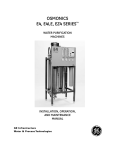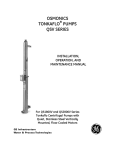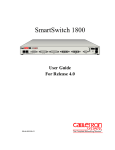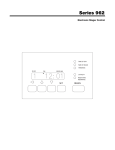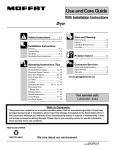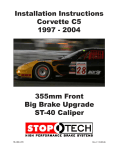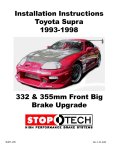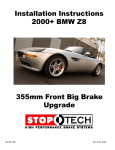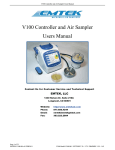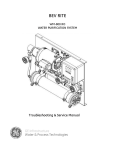Download GE SS1000 User's Manual
Transcript
OSMONICS TONKAFLO PUMPS SS SERIES INSTALLATION, OPERATION, AND MAINTENANCE MANUAL For SS500, SS1000, and SS1800 Series Tonkaflo Centrifugal Pumps with X, XB, and XC Motor Adapters Without Bearing Frames GE Infrastructure Water & Process Technologies INSTALLATION, OPERATION AND MAINTENANCE MANUAL FOR SS500, SS1000 AND SS1800 SERIES TONKAFLO CENTRIFUGAL PUMPS WITH X-, XB- OR XC-FRAMES MOTOR ADAPTERS WITHOUT BEARING FRAME TABLE OF CONTENTS Page 1.0 INTRODUCTION 1 2.0 TONKAFLO SPECIFICATIONS 2 2.1 2.2 2.3 2.4 2.5 2.6 2.7 2 3 3 3 3 4 4 3.0 Capacities Maximum Developed Boost Pressure Maximum Recommended Operating Temperature Standard Materials of Construction Special Materials of Construction Pump Nomenclature Special Liquids PUMP INSTALLATION 3.1 3.2 3.3 3.4 3.5 3.6 Inspection Pump Mounting and Location Inlet and Discharge Piping and Connections 3.3.1 Inlet Piping 3.3.2 Discharge Piping 3.3.3 Pump Piping Connections 3.3.4 Inlet Line Screen/Filter 3.3.5 Discharge Screen (Strainer) Pump Priming Protection Against Running Dry Motor Wiring 3.6.1 Single-Phase Motors 3.6.2 Three-Phase Motors 3.6.3 Three-Phase Power Imbalance 5 5 5 5 5 6 7 7 7 8 8 9 9 9 10 Page 4.0 GENERAL TROUBLESHOOTING FOR ALL PUMPS 12 4.1 4.2 4.3 12 13 4.4 5.0 Troubleshooting Chart Mechanical Seal Leakage Mechanical Seal Replacement: SS500, SS1000 and SS1800 Series Pumps High-Pressure Mechanical Seal Replacement: SS500, SS1000 and SS1800 Series 13 16 TONKAFLO PUMP FIELD MAINTENANCE 17 5.1 5.2 5.3 5.4 5.5 17 17 18 18 19 Motor Bearing Lubrication Motor Removal: XB and XC Motor Adapter Pump Motor Installation: XB and XC Motor Adapter Pump Motor Removal: X Motor Adapter Pump Motor Installation: X Motor Adapter Pump 6.0 LIQUID END, TONKAFLO SERVICE POLICY 21 7.0 TONKAFLO PUMP RETURNED GOODS AUTHORIZATION (RGA) PROCEDURE 22 7.1 7.2 7.3 22 22 22 8.0 9.0 Motor Warranty In-of-Warranty Pump Failure Out-of-Warranty Pump Failure DIMENSIONAL DRAWINGS 23 8.1 8.2 8.3 8.4 8.5 23 24 25 26 27 500X Motor Adapter Pump 500XB Motor Adapter Pump 1000X and 1800X Motor Adapter Pump 1800XB Motor Adapter Pump 1800XC Motor Adapter Pump CUTAWAY DRAWINGS 28 9.1 9.2 28 29 X Motor Adapter Pump XB and XC Motor Adapter Pump Page 10.0 STANDARD MODEL PARTS LIST 30 10.1 10.2 10.3 30 31 32 Spare Parts List Accessories Mechanical Seal Replacement Kit 11.0 ORDERING PARTS 33 12.0 TONKAFLO PUMP WARRANTY 34 LIST OF FIGURES Figure Title 3.1 3.2 3.3 3.4 4.5 4.6 Inlet Piping Installation of Discharge Screen Changing Motor Rotation Rolling the Leads to Balance Current Draw Removal of Pump Liquid-End from Motor Adapter Removal of Mechanical Seal Holder from Motor Adapter Removal of Mechanical Seal from Pump Shaft and Cavity of Mechanical Seal Holder 500X Motor Adapter Pump 500XB Motor Adapter Pump 1000X and 1800X Motor Adapter Pump 1800XB Motor Adapter Pump 1800XC Motor Adapter Pump X Motor Adapter Pump XB and XC Motor Adapter Pumps 4.7 8.8 8.9 8.10 8.11 8.12 9.13 9.14 6 8 10 11 14 14 15 23 24 25 26 27 28 29 LIST OF TABLES Table Title 2.1 2.2 Capacities Maximum Developed Boost Pressure 2 3 1.0 INTRODUCTION This manual contains information important to the installation, operation, and maintenance of your Tonkaflo multi-stage centrifugal pump. Your Tonkaflo pump has been designed for reliable service in many types of pumping applications. Proper installation and normal maintenance will help ensure extended pump life and prevent costly downtime. Before installing and operating your Tonkaflo pump, read these instructions carefully and keep this manual handy for future reference. This manual is intended for general maintenance only. Further information may be obtained by contacting your nearest Tonkaflo distributor or GE Infrastructure at: GE Infrastructure Water & Process Technologies 5951 Clearwater Drive Minnetonka, MN 55343-8995 USA Phone: Toll Free: Fax: (952) 933 - 2277 (800) 848 - 1750 (952) 988 - 6060 This manual is not intended for repair or overhaul of the Tonkaflo pump liquid ends. Only the factory and those certified by the Factory Service School are authorized to repair, service, or overhaul of Tonkaflo pump liquid ends. Your new Tonkaflo multi-stage centrifugal pump is designed for quiet, smooth-running, and highly efficient operation. The materials of construction make Tonkaflo pumps suitable for many chemical and pure water applications. Tonkaflo pumps' unique modular design allows the user to choose the number of stages which most closely match the desired performance and, thereby, achieve the highest pumping efficiency. Unlike many other pump manufacturers, Tonkaflo will produce pumps to fit your particular applications should a standard model pump not suit your requirements. NOTE: This manual, along with all GE Infrastructure manuals, is available at www.ge.water.com. 1 2.0 TONKAFLO SPECIFICATIONS The Tonkaflo pumps covered in this instruction manual are the lower capacity SS500, SS1000, and SS1800 Series pumps. These pumps cover a flow range of 1.5 - 18 gpm (0.34 - 4.1 m3/h) with single unit pressure up to 700 psig (48.3 barg). The capacity and discharge pressure can be increased by operating pumps in parallel or series, respectively. There is no maximum limit on capacity when operating Tonkaflo pumps in parallel. When operating pumps in series, the maximum rated discharge is 750 psig (51.7 barg) with standard pumps, and 1000 psig (69 barg) with optional high-pressure construction on the downstream pump. With inlet pressures greater than 200 psig (13.8 barg), optional high-pressure mechanical seals should be used. 2.1 Capacities Table 2.1 Capacities 2900 rpm 50 Hertz Minimum - Maximum 3500 rpm 60 Hertz Minimum - Maximum 500 1 - 6 gpm 3 (0.23 - 1.4 m /h) 1.5 - 7 gpm 3 (0.34 - 1.6 m /h) 40% 1000 3.3 - 11 gpm 3 (0.75 - 2.5 m /h) 4 - 13 gpm 3 (0.91 - 30. m /h) 49% 1800 4 - 17.5 gpm 3 (0.91 - 4.0 m /h) 5 - 21 gpm 3 (1.14 - 4.8 m /h) 57% SS Series NOTE: Maximum Efficiency There must be adequate flow at all times through the pump to prevent excessive heat build-up. 2 2.2 Maximum Developed Boost Pressure Table 2.2 Maximum Developed Boost Pressure Maximum Developed Pressure psig (barg) 2.3 Number of Centrifugal Stages SS Series 50 Hertz 60 Hertz 50 Hertz 60 Hertz 500 630 (43.4) 700 (48.3) 76 58 1000 300 (20.7) 340 (23.4) N/A 28 1800 570 (39.3) 680 (46.9) 56 48 Maximum Recommended Operating Temperature The maximum recommended operating temperature range is 125°F (52°C). The maximum operating temperature is dependent upon the operating pressure. For high temperature applications, consult the factory for special materials of construction. The maximum recommended temperature is stated on the pump case. The temperature stated is for the design flow and pressure. 2.4 Standard Materials of Construction SS: 2.5 Wetted castings and pump shaft are 316 stainless steel (SS). The pump casing is 316SS. Impellers and diffusers are Noryl. The mechanical seal has a carbon rotating face and a ceramic stationary face. The secondary sealing element of the mechanical seal is Buna-N. The O-rings and diffuser bearings are Buna-N. Special Materials of Construction Optional ethylene propylene (EPDM), Viton*, and Teflon* elastomers are available. Contact the factory. * Viton and Teflon are trademarks of E.I. DuPont de Nemours and Company, Inc. 3 2.6 Pump Nomenclature Example: Model S S 5 0 5 X SS 5 05 X = = = = Model S S 1 8 4 8 X B - 5 0 SS 18 48 XB Materials of Construction Series 500 Number of Stages Motor Adapter, No Bearing Frame, 56J Motor 50 2.7 = = = = Materials of Construction Series 1800 Number of Stages Motor Adapter, No Bearing Frame, 182/184TC Motor = 50 Hertz Operation Special Liquids For liquids other than water, aqueous solutions, or corrosive solutes, consult the factory for compatibility. 4 3.0 PUMP INSTALLATION 3.1 Inspection Your pump was inspected and tested at the factory prior to shipment to ensure it meets the requirements of your order. It is suggested the pump be checked upon receipt for possible damage due to shipping. Any damage should be immediately reported to the carrier. 3.2 Pump Mounting and Location The pump is supported by the motor base, and on longer pumps, a support at the discharge end. The X, XB, and XC motor adapter pumps may be mounted and operated in either a horizontal or vertical position. The vertical position requires the motor to be up. The inlet casting may be rotated to any of four positions by removing the four (4) bolts on the inlet casting, turning the inlet casting to the desired position and replacing the 4 bolts. When mounting the pump, be sure the pump casing support and motor base are in line and on the same plane so that no stress results in the pump after fastening down. CAUTION: 3.3 The inlet and discharge piping should be independently supported. Inlet and Discharge Piping and Connections 3.3.1 Inlet Piping THE INLET PIPING AND PUMP MUST BE FILLED WITH LIQUID (i.e., PRIMED) BEFORE START-UP. A pressure/vacuum gauge installed in the inlet piping to measure positive or negative pressure is recommended. Be sure the pump is not mounted above the liquid source and the inlet (suction) plumbing not restricted so adequate suction pressure is available. The inlet piping should be at least as large as the pump inlet port. The discharge piping should be sized to properly handle the maximum flow and pressure developed by the pump. The recommended pipe size for most applications should result in frictional line loss of 5 psig/100 feet (0.34 barg/100 meters) or less for suction lines and 10 psig/100 feet (0.7 barg/100 meters) or less for discharge lines. A larger pipe size will reduce the frictional line loss. The pump inlet piping should be designed to avoid areas where air may be trapped and accumulate. Keep the inlet pipe free of high points, which could trap air and could disrupt pump priming and start-up. Pump inlet pipe size changes just ahead of the pump should be tapered. Reducers should be eccentric to avoid air pockets. 5 IMPORTANT: Should your application require pump operation with a negative gauge pressure at the inlet, consult the factory or your local Tonkaflo pump distributor. When the pump operates with a suction lift, the suction pipe should slope upward to the pump from the source of supply. Provision must be made for priming the pump. To maintain pump prime, a foot valve can be used with an opening at least as large as the inlet piping. When pumping liquid from a tank, the suction line must be submerged enough so air is not drawn into the suction line from a vortex. Increasing the size of the inlet pipe to reduce the velocity will help to prevent the vortex from forming. Hot liquids within the temperature range of the pump must have sufficient positive head to prevent vaporization at the impeller inlet. The Net Positive Suction Head (NPSH) required data are included on the pump performance curves provided with this instruction manual. The pump must never be throttled on the suction side. After installation, test the suction line with water with a range of 20 - 100 psig (1.4 - 6.9 bar) pressure to detect any leaks. Figure 3.1 Inlet Piping 3.3.2 Discharge Piping The discharge piping should be sized to properly handle the maximum flow and pressure developed by the pump. 6 Size selected should result in frictional line loss of 5 psi/100 ft (1.1 kPa/M) or less for suction lines and 10 psi/100 ft (2.3 kPa/M) or less for discharge lines. A larger pipe size will reduce the frictional line loss. WARNING: 3.3.3 THE PUMP MUST NOT RUN WITH A CLOSED DISCHARGE OR IRREVERSIBLE DAMAGE TO THE WETTED INTERNAL PARTS OF THE PUMP WILL RESULT! Pump Piping Connections The standard inlet and discharge connections for a Series 500 pump is a 3/4-inch NPT female pipe thread, and for Series 1000 and 1800 pumps is 1-1/4-inch Victaulic couplings/clamped unions with gasket. Victaulic couplings are available worldwide. Contact the factory or your local industrial piping wholesaler. 3.3.4 Inlet Line Screen/Filter This is a precision multi-stage pump with close tolerances to provide maximum efficiency. It is good practice to install a large area 30-mesh or finer screen, or a cartridge filter in the pump inlet line to collect any foreign objects or large particles. Size the screen or filter so as to induce a minimal pressure drop. WARNING: THE PUMP MUST NOT BE OPERATED WITH RESTRICTED SUCTION LINE (INLET) FLOW. Positive gauge pressure must be maintained at the pump inlet (downstream from the screen or filter). A clogged screen or filter will result in a greater pressure drop than a clean screen or filter. To prevent possible pump damage from low inlet pressure, a low-pressure alarm or shut-off switch should be located between the screen or filter and the pump. A low-flow shut-off switch should also be located in the same area. 3.3.5 Discharge Screen (Strainer) A 30-mesh screen (available as an accessory for 500, 1000 and 1800 Series pumps) located in the discharge piping will protect your process fluid should the pump be damaged. The installation of the screen is shown in Figure 3.2 (Installation of Discharge Screen). 7 Figure 3.2 Installation of Discharge Screen 3.4 Pump Priming IMPORTANT: THE INLET PIPING AND PUMP MUST BE FILLED WITH LIQUID (i.e., PRIMED) BEFORE START-UP. If the pump is above the liquid source, fill the pump and supply line with liquid from an external source. WARNING: THE PUMP MUST BE SHUTOFF IMMEDIATELY IF PRIME IS LOST TO AVOID POSSIBLE DAMAGE TO THE INTERNALS OF THE LIQUID END. WARNING: NEVER RUN PUMP DRY. The liquid end of your Tonkaflo pump is lubricated by the process fluid. The pump must never be run dry to avoid damage to the liquid end. 3.5 Protection Against Running Dry It is suggested that controls to protect the pump from running dry be used. These controls include: pressure switches, flow switches, and temperature switches. 8 3.6 Motor Wiring 3.6.1 Single-Phase Motors When initially connecting to the power source, be certain that the motor voltage connections and available line voltage are the same. Connect electrical wires as shown on the motor wiring diagram located on the motor nameplate, electrical junction box, junction box cover, or wiring tag. Be sure your pump is electrically grounded at the junction box on the motor. 3.6.2 Three-Phase Motors The wiring diagram located on the motor nameplate, electrical junction box, junction box cover, or wiring tag should be used to correctly wire the motor according to the line voltage available. Be sure your pump is electrically grounded at the junction box on the motor. CAUTION: The 500X, 1000X and 1800X motor adapter pumps have a threaded motor shaft. Reverse operation can damage the motor shaft, pump shaft, or centrifugal stages. Before Starting Three-Phase Motors: STEPS 1. Prime pump before applying power to avoid damage to the pump. 2. Apply power for ONE SECOND MAXIMUM to check the direction of motor shaft rotation. The motor shaft should turn in a clockwise direction as viewed from the motor end. The direction of rotation for threephase motors may be reversed by interchanging any two (2) leads (Figure 3.3, Changing Motor Rotation). Three-phase motors can run in either direction, depending on how they are connected to the power supply. When the three cable leads are first connected to the power supply, there is a 50% chance that the motor will run in the proper direction. To make sure the motor is running in the proper direction, carefully follow the procedure below. STEPS A. Start the pump and note the pressure and flow rate developed at the pump discharge. B. Stop the pump and interchange any of the two leads. C. Start the pump again and recheck the flow rate and pressure. 9 D. Compare the results observed. The wire connection that yielded the highest pressure and flow rate is the proper connection. Interchange the two leads only if necessary (Figure 3.3, Changing Motor Rotation). Figure 3.3 Changing Motor Rotation 3.6.3 Three-Phase Power Imbalance Current imbalance should not exceed 5% of the average three-phase current. The current imbalance can be calculated as follows: STEPS 1. Measure the current through each of the three legs. 2. Average the three current measurements together. 3. Determine the difference between the current in each leg and the average of all three legs. 4. Take the difference with the largest value, and divide it by the average current. Multiply by 100 to obtain the current imbalance percentage. 5. If the current imbalance is greater than 5%, “roll” the leads and retest (Figure 3.4, Rolling the Leads to Balance Current Rotation). If “rolling” the leads does not correct the problem, the source of imbalance must be located and corrected. For more information on current imbalance, refer to the motor operation manual. 10 Figure 3.4 “Rolling” the Leads to Balance Current Draw 11 4.0 GENERAL TROUBLESHOOTING FOR ALL PUMPS 4.1 Troubleshooting Chart LOW FLOW 1. 2. 3. 4. 5. 6. 7. 8. 9. 10. MOTOR RUNS HOT OR STOPS Restrictions in inlet or discharge Foot valve operating improperly Air leak in inlet piping Air leak in mechanical seal Wrong installation of belt drive Suction lift too high Reverse rotation of pump shaft Pump not primed adequately Inlet strainer/filter plugged. Pump throttling valve on discharge closed (pump deadheaded) 1. Motor surface temperature up to 104°F (40°C) over ambient can occur. The motor will feel hot to the touch. 2. Bad connection 3. Motor exceeded rated amp draw 4. Excessive ambient temperature 5. Heater size to small in motor heater 6. Binding rotation in the pump shaft 7. Bearings not adequately lubricated 8. Specific gravity or viscosity of liquid higher than design conditions 9. Motor wired improperly MOTOR DOES NOT RUN 1. 2. 3. 4. 5. 6. LOW PRESSURE Blown fuse or tripped circuit breaker or overload heater Motor to hot - allow to cool Motor voltage connection and line voltage different Bad connection Motor wired improperly Wrong ratio for belt drive 1. 2. 3. 4. 5. 6. 7. PUMP VIBRATION 1. 2. 3. 4. 5. 6. 7. Pump not adequately primed Air leak in inlet piping Excessive flow Clogged suction line filter or screen Reverse rotation of pump shaft Foot valve operating improperly Wrong ratio for belt drive PUMP LEAKING Misalignment of flexible coupling Bent pump shaft Improper mounting Starved suction Worn bearings Motor out of balance Operating beyond specified capacity range of the pump 12 1. 2. 3. 4. Mechanical seal needs replacing O-rings in pump casing damaged Oil seals need replacing Piping not sealed properly 4.2 Mechanical Seal Leakage WARNING: POWER MUST BE DISCONNECTED BEFORE MAINTENANCE! If liquid is leaking from the hole on the bottom or on either side of the motor adapter, the mechanical seal may need to be replaced. With new pumps, pumps with new mechanical seals, or pumps which have been dormant for long periods, the seal faces may not be completely seated and a slight leakage will occur. If this leakage continues for more than 60 seconds, the first remedy is to remove the discharge piping and tap the pump shaft using a wooden dowel to seat the seal. WARNING: BE CAREFUL NOT TO DAMAGE THE SHAFT. If this does not stop the leak, then the liquid end assembly needs to be partially removed to gain access to the mechanical seal as shown in Figure 4.5 (Removal of Pump Liquid-End from Motor Adapter) or Figure 4.6 (Removal of Mechanical Seal from Motor Adapter). The ceramic seal seat also needs to be wiped clean and then coated very lightly with oil or Vaseline. Also, the carbon wear ring needs to be wiped clean and coated lightly with petroleum grease. Then, reassemble the pump. 4.3 Mechanical Seal Replacement: SS500, SS1000 and SS1800 Series Pumps NOTE: On Tonkaflo X frame pumps, the mechanical seal must be replaced by removal of the complete liquid end assembly from the pump shaft. On Tonkaflo XB and XC frame pumps, you can service the mechanical seal by either removing the complete liquid end assembly from the pump shaft, or by loosening the cone-point set screw which secures the pump shaft to the shaft coupler, and removing the pump shaft with the liquid end assembly. STEPS 1. Remove the four (4) 5/16-inch bolts and lock washers from the inlet casting and firmly grasp the liquid end (Figure 4.5, Removal of Pump Liquid-End from Motor Adapter). Pull the liquid end straight off the pump shaft being careful not to bend the pump shaft. Two (2) flat-blade screwdrivers may be needed to remove the seal holder from the liquid end assembly. WARNING: 2. EXTREME CARE MUST BE TAKEN NOT TO BEND PUMP SHAFT! Remove the stainless steel retaining ring (size 5160-62H) from the pump shaft using the proper size retaining ring pliers (Truarc L1520 or equivalent). These pliers are available from the factory or can be purchased from a local source. 13 Figure 4.5 Removal of Pump Liquid-End from Figure 4.6 Removal of Mechanical Seal Holder from Motor Adapter 14 Figure 4.7 Removal of Mechanical Seal from Pump Shaft and Cavity of Mechanical Seal Holder 3. Remove the rotary portion (spring, washer, and face assembly) of the seal assembly from the pump shaft by rotating and pulling the rotary portion until it slides off the pump shaft (Figure 4.6, Removal of Mechanical Seal Holder from Motor Adapter). 4. Remove the mechanical seal holder from the motor adapter by sliding the holder off the pump shaft. Two (2) flat-blade screwdrivers may be needed to remove seal holder from the motor adapter (Figure 4.6). 5. Remove the stationary seat of the mechanical seal from the cavity of the mechanical seal holder (Figure 4.7, Removal of Mechanical Seal from Pump Shaft and Cavity of Mechanical Seal Holder). 6. Install the new stationary seat into the seal holder cavity. Lubricate the rubber boot on the outside of the stationary seal with petroleum or silicone grease before replacement. Make sure the stationary seat is fully seated. Lightly lubricate the ground surface of the stationary seat with grease. 15 7. Examine the rubber O-ring on the mechanical seal holder and, if the O-ring is damaged, replace it with a new one. A new O-ring is included with the factory-supplied Mechanical Seal Replacement Kit (Section 10.3). Be sure to lubricate with grease before installing. 8. Place the mechanical seal holder containing the new stationary seat onto the pump shaft and slide it down the shaft until fully engaged with the motor adapter. Care must be taken not to damage seal seat when sliding over the pump shaft. 9. Lubricate the round surface of the pump shaft with grease. After lubrication, replace the rotary portion of the mechanical seal by placing onto the pump shaft and carefully rotating and pushing it down the pump shaft until it is fully seated against the stationary portion of the mechanical seal. WARNING: 10. Place the stainless steel retaining ring back onto the shaft to hold the rotary portion of the mechanical seal in place with the square edges of the retaining ring away from the seal spring. A retaining ring is included in the factory supplied mechanical seal replacement kit. Use of retaining rings that are not stainless steel or equivalent may cause the seal to fail in operation. 11. Be sure the retaining ring is properly seated in the groove on the pump shaft. 12. Firmly grasp the liquid end and insert the splined pump shaft into the liquid end by carefully rotating the liquid end clockwise and then counterclockwise while applying light pressure toward the motor adapter. Be sure the splined shaft and splined bore of each impeller meshes properly until the inlet casting mates with the mechanical seal holder. It may be necessary to lift the assembly up slightly when rotating it, then place it onto the splined shaft. WARNING: 13. 4.4 USE CARE WHEN SLIDING THE ROTARY PORTION OF THE MECHANICAL SEAL OVER THE RETAINING RING GROOVE IN THE PUMP SHAFT. THE RUBBER ON THE MECHANICAL SEAL CAN BE DAMAGED IF NOT LUBRICATED WITH GREASE. CARE MUST BE TAKEN NOT TO BEND THE PUMP SHAFT OR TO FORCE THE SHAFT INTO THE IMPELLER BORE. Install the four (4) 5/16-inch bolts and lock washers and tighten. High-Pressure Mechanical Seal Replacement: SS500, SS1000 and SS1800 Series Pumps High pressure mechanical seals have the same basic design as standard mechanical seals. Replace them using the same procedure as denoted in Section 4.3 (Mechanical Seal Replacement SS500, SS1000 and SS1800 Series Pumps), Figure 4.6 (Removal of Mechanical Seal Holder from Motor Adapter), and Figure 4.7 (Removal of Mechanical Seal from Pump Shaft and Cavity of Mechanical Seal Holder). 16 5.0 TONKAFLO PUMP FIELD MAINTENANCE 5.1 Motor Bearing Lubrication Motors up to 3 Hp typically have sealed bearings. Motors of 5, 7.5, and 10 Hp may or may not have sealed bearings. For these larger motors, lubrication intervals vary between manufacturers but generally lubrication every 2000 hours is required. Consult Your Local Motor Distributor For Lubrication Advice, or the motor information supplied with your pump. 5.2 Motor Removal: XB and XC Motor Adapter Pumps STEPS 1. Disconnect the motor electrical power. 2. Remove the wiring to the motor. 3. Remove the piping from the pump. 4. Remove the pump mounting bolts, and place the pump on a work bench. 5. Remove the cone-point set screw from the shaft coupler, which is located through either side port in the motor adapter adjacent to the inlet housing. Do not remove the two knurled cup-point set screws securing the shaft coupler to the motor shaft at this time. 6. Remove the four (4) 5/16-18NC bolts that hold the pump liquid end to the motor adapter. 7. Slide the liquid end assembly away from the motor adapter 1/4- to 1/2-inch (6 - 13 mm). 8. Use two (2) flat-blade screwdrivers or small pry bars to remove the seal holder from the motor adapter along with the pump shaft (Figure 4.5, Removal of Pump Liquid-End from Motor Adapter). Remove the liquid-end assembly including the pump shaft as a unit. 9. Remove the four (4) 1/2-12NC bolts that hold the motor adapter to the motor and remove the motor adapter. 10. Loosen the two set screws that hold the shaft coupler to the motor shaft, and remove the shaft coupler. The motor may now be serviced by a qualified vendor or replaced (Figure 4.6, Removal of Mechanical Seal Holder from Motor Adapter). 17 5.3 Motor Installation: XB and XC Motor Adapter Pumps STEPS 5.4 1. On a used motor, file the motor shaft smooth where the set screws were seated. 2. Coat the motor shaft with an anti-seize compound. 3. Slide the shaft coupler onto the motor shaft until fully seated, and tighten the two set screws. 4. Place the motor adapter onto the motor, such that the one drain hole is located down and the four side access ports are horizontal when the pump is reinstalled. 5. Coat the round end of the pump shaft and shaft key with an anti-seize compound. 6. Place the pump liquid-end assembly with pump shaft and shaft key into the motor adapter, with the key aligned with the coupler key way. 7. Install the four (4) 5/16-18NC bolts and tighten. 8. Using a wood dowel, place it against the pump shaft end located in the discharge port. Tap on the end of the wood dowel until the pump shaft is fully seated in the shaft coupler, and then tighten the cone-point set screw (Figure 4.6, Removal of Mechanical Seal Holder from Motor Adapter). 9. Reinstall the pump and pump piping connections. 10. Reinstall the motor wiring. 11. For pump start-up see Section 3.0 (Pump Installation). Motor Removal: X Motor Adapter Pumps STEPS 1. Disconnect the motor electrical power. 2. Remove the wiring to the motor. 3. Remove the piping from the pump. 4. Remove the pump mounting bolts, and place the pump on a work bench. 5. Remove the four (4) 5/16-18NC bolts that hold the pump liquid end to the motor adapter. 18 5.5 6. Slide the liquid end assembly off of the pump shaft, taking care not to bend the pump shaft. 7. Remove the retaining ring and remove. The rotary head of the mechanical seal. 8. Remove the seal holder along with the stationary seal seat. 9. Remove the four (4) 3/8-16NC bolts that hold the motor adapter to the motor, and remove the motor adapter. 10. Remove the pump shaft assembly where it is screwed to the threaded motor shaft by first heating the joint area to loosen the thread-locking compound. Secure the motor shaft using a vise grip, and loosen the pump shaft assembly. An impeller may be used to grip the shaft, taking proper care not to damage the impeller. Or, use a vise grip and fabric rug to grip the splined shaft, taking care not to damage the splines. 11. The motor can now be serviced by a qualified service center, or replaced. Motor Installation: X Motor Adapter Pumps STEPS 1. To re-use a repaired motor, clean the threads on the shaft of any threadsealant residue. 2. Reinstall the pump shaft onto the threaded motor shaft until fully seated. Rotate the pump shaft to make sure it runs true. Run-out should be less than 0.03 inch (0.76 mm) for every 10 inches of pump shaft length. 3. Loosen the pump shaft from the motor shaft, apply thread sealant to the threads, and tighten the shaft again until fully seated. Use standard strength thread sealant on single-phase motors, and a high-strength thread sealant on three-phase motors. 4. Install the motor adapter onto the motor and install and tighten the four bolts into the motor. 5. Position the seal holder into the motor adapter, using Vaseline or grease on the O-ring as a lubricant. Replace the O-ring if damaged. 6. Install a new mechanical seal stationary seat, using Vaseline, grease, or water as a lubricant on the rubber portion. 7. Install the rotary portion of the mechanical seal using a small amount of Vaseline lubricant on the round body of the shaft, and also on the face of the ceramic seat face where the carbon wear ring contacts it. 19 8. Install the retaining ring into the shaft groove with the sharp edges away from the motor. 9. Install the liquid end assembly onto the pump shaft. Do not force it in. Rotate and place the liquid end onto the mechanical seal holder until seated against motor adapter. 10. Install the four (4) 5/16-inch lock washers and bolts to hold the liquid end onto the motor adapter and tighten. 11. Reinstall the pump (Section 3.0, Pump Installation). 20 6.0 LIQUID END - TONKAFLO SERVICE POLICY Sections 4.0 (General Troubleshooting for All Pumps) and 5.0 (Tonkaflo Pump Field Maintenance) in the Tonkaflo Installation, Operation, and Maintenance Manual were written to assist our customers in performing minor maintenance in the field of Tonkaflo pumps. Proper maintenance will ensure longer pump life and minimize downtime. Tonkaflo pumps are manufactured to make field repairs on the mechanical seal a quick and easy process. If a repair at the factory is desired, call the factory for a Return Goods Authorization (RGA) number (Section 7.0) and follow the directions provided by a GE representative. For motor problems, such as worn-out motor bearings, it is recommended that maintenance be done at a local motor repair shop. WARNING: FIELD SERVICE OF THE LIQUID END, WITH THE EXCEPTION OF MECHANICAL SEAL REPLACEMENT, IS NOT RECOMMENDED. If a liquid end is damaged by running the pump dry, inadequate flow, deadheading, cavitation, or other reasons, return it with the motor to the factory for repair. 21 7.0 TONKAFLO PUMP RETURN GOODS AUTHORIZATION (RGA) PROCEDURE If you wish to return goods for repair, warranty evaluation and/or credit, please have your original sales order or invoice available when you call GE. Call (800) 848-1750 and ask to speak with Customer Service. A GE Customer Service representative will provide instructions and a return authorization number which needs to be clearly written on the outside of the box used to ship your materials. All equipment must be shipped to GE with the freight prepaid by the customer. Call our Customer Service Center with any questions or issues concerning freight claims and a representative will discuss your situation. All materials to be returned must be rendered into a non-hazardous condition prior to shipping. There are two ways to handle a return: (1) send in the pump for repair and return or (2) purchase a new pump and when desired, send the defective pump to the factory for repair and return. 7.1 Motor Warranty Motors must be sent to the nearest authorized motor service station center for repair, replacement, and warranty disposition. 7.2 In-Warranty Pump Failure STEPS 7.3 1. Return the defective pump to the factory for repair, on an RGA, within 15 days. from RGA issue date. GE absorbs the cost of repair. The repaired pump will be returned and is under warranty for the remainder of the original warranty period or three months, whichever is longer. 2. GE will not restock or issue return credit against a new, customer-built, pump purchase regardless of the warranty status of the failed pump. The warranty (Section 12.0, Tonkaflo Pump Warranty) is 12 months from installation or 15 months from receipt, whichever occurs first. Out-of-Warranty Pump Failure Return the pump on an RGA for repair. The pump will be repaired and repair charges invoiced to the customer. The warranty for repairs is three months. 22 8.0 DIMENSIONAL DRAWINGS 8.1 500X Motor Adapter Pumps Figure 8.8 500X Motor Adapter Pump 23 8.2 500 XB Motor Adapter Pumps Figure 8.9 500 XB Motor Adapter Pump 24 8.3 1000X and 1800X Motor Adapter Pumps Figure 8.10 1000X and 1800X Motor Adapter Pump 25 8.4 1800XB Motor Adapter Pumps Figure 8.11 1800XB Motor Adapter Pump 26 8.5 1800XC Motor Adapter Pumps Figure 8.12 1800XC Motor Adapter Pump 27 9.0 CUTAWAY DRAWINGS 9.1 X Motor Adapter Pump Figure 9.13 X Motor Adapter Pump 28 9.2 XB and XC Motor Adapter Pump Figure 9.14 XB and XC Motor Adapter Pump 29 10.0 STANDARD MODEL PARTS LIST 10.1 Spare Parts List Part Number Item Description Series 500X 1000X 1800X Series 500XB 1800XB Series 1800XC Specify Model Specify Model Specify Model 1 Liquid End Assembly 2 Motor Adapter 1123229 1125921 1125921 4 Shaft Coupler N/A 1125795 1125758 5 Set Screw, Shaft Coupler N/A 1125137 1125137 6 Set Screw, Cone-Point 1113769 1113769 1113769 7 Pump Shaft Key, 3/16 x 3/16 x 1-inch 1120062 1120062 1120062 8 Pump Shaft Extension & Sleeve N/A 1123244 1123244 9 Spiral Pin N/A 1120500 1120500 10 Pump Shaft Specify Model Specify Model Specify Model 11 Seal Holder, SS 1122719 1122719 1122719 12 O-ring, Buna-N 1122786 1122786 1122786 13a Mechanical Seal, Standard Kit 1121174 1121174 1121174 13b Mechanical Seal, 300 psig (barg), Kit 1120312 1120312 1120312 13c Mechanical Seal, 400 psig (barg), Kit 1120477 1120477 1120477 14 (a) Retaining Ring 1120054 1120054 1120054 15 Discharge Bracket 1120659 1120075 1125914 16 Clamp, Discharge 1112951 1112951 1112951 30 Part Number Item Description Series 500X 1000X 1800X Series 500XB 1800XB Series 1800XC 17a Bolt, 5/16-18NC x 1 1113102 1113102 1113102 18 Lock washer, 5/16 1112256 1112256 1112256 19a Bolt, 3/8-16NC x 1.25 Long 1110984 N/A N/A 19b Bolt, 1/2-13NC x 1.25 Long N/A 1113973 1113973 20a Lock washer, 3/8 1110012 N/A N/A 20b Lock washer, 1/2 N/A 1113104 1113104 10.2 Accessories Part Number Series 500X 1000X 1800X Series 500XB 1800XB Series 1800XC Installation, Operation, and Maintenance Manual 1125857 1125857 1125857 Retaining Ring Pliers 1120108 1120108 1120108 Loctite 242 Standard Strength, 0.5 cc tube 1120109 N/A N/A Loctite 271 High Strength, 50 cc bottle 1113690 N/A N/A Anti-Seize, Thread Compound 1120110 1120110 1120110 Description 31 10.3 Mechanical Seal Replacement Kit Part Number Series 500X 1000X 1800X Series 500XB 1800XB Series 1800XC Standard, 200 psig (13.8 barg) 1121174 1121174 1121174 High-Pressure, 300 psig (20.7 barg) 1120312 1120312 1120312 High-Pressure, 400 psig (27.8 barg) 1120477 1120477 1120477 N/A 1113770 1113770 Victaulic Adapters, 1.25 x 1.25, M-NPT, 316SS 1113653 1113653 1113653 Victaulic Adapters, 1.25 x 1, F-NPT, 316SS 1120797 1120797 1120797 Victaulic Adapters, 1.25 x 0.75, F-NPT, 316SS 1120229 1120229 N/A Victaulic Coupling, 1.25, 1000 psig (69 barg) 1110597 1110597 1110597 Pump Discharge Screen, 1.25 1120264 1120264 1120264 Description Allen Wrench, 3/16-inch 32 11.0 ORDERING PARTS Order parts through your local distributor or directly from: GE Infrastructure Water & Process Technologies 5951 Clearwater Drive Minnetonka, MN 55343-8995 USA Phone Fax: Toll Free (952) 933-2277 (952) 933-0141 (800) 848-1750 To order parts, the following information is necessary: 1. Pump model number 2. Pump serial number (from nameplate) 3. Other nameplate information such as operating temperature or material code, and type of mechanical seal 4. Motor horsepower, motor frame size and enclosure specifications 5. Part name 6. Part number 7. Quantity desired 8. Special materials of construction, if any. 33 12.0 WARRANTY TONKAFLO PUMP WARRANTY GE warrants its pumps to be free from defects in design, material, or workmanship for a period of 15 months from receipt or 12 months from installation of the product, whichever occurs first, when said products are operated in accordance with written instructions and are installed properly. If Tonkaflo pumps are altered or repaired without prior approval of GE, all warranties are void. If any defects or malperformance occur during the warranty period, GE’s sole obligation shall be limited to alteration, repair or replacement at GE's expense, freight on board (F.O.B.) factory, of parts or equipment which, upon return to GE and upon GE’s examination, prove to be defective. Equipment and accessories not manufactured by GE are warranted only to the extent of and by the original manufacturer's warranty. GE shall not be liable for damage or wear to equipment caused by abnormal conditions, excessive temperatures, vibration, failure to properly prime or to operate equipment without flow, or caused by corrosives, abrasives or foreign objects. The foregoing warranty is exclusive and in lieu of all other warranties, whether expressed or implied including any warranty of merchantability or fitness for any particular purpose. In no event shall GE be liable for consequential or incidental damages. Pump Model Number: Pump Serial Number: P/N 1125857 Rev B 34 For more information call 952-933-2277 or 800-848-1750 in the U.S., or visit www.gewater.com. GE Infrastructure Water & Process Technologies North American Sales 5951 Clearwater Drive Minnetonka, MN 55343-8995 USA (952) 933-2277 Phone (952) 933-0141 Fax Euro/Africa Sales 230 rue Robert Schurman ZA des Uselles 77350 Le Mée sur Seine FRANCE +33 1 64 10 2000 Phone +33 1 64 10 3747 Fax © 2004, General Electric Company. All rights reserved. P/N 1125857 Rev. B Asia/Pacific Sales 1044/8 SOI 44/2 Sukhumvit Road Parkanog Bangkok 10110 THAILAND + 66 2 38 14213 Phone + 66 2 39 18183 Fax










































